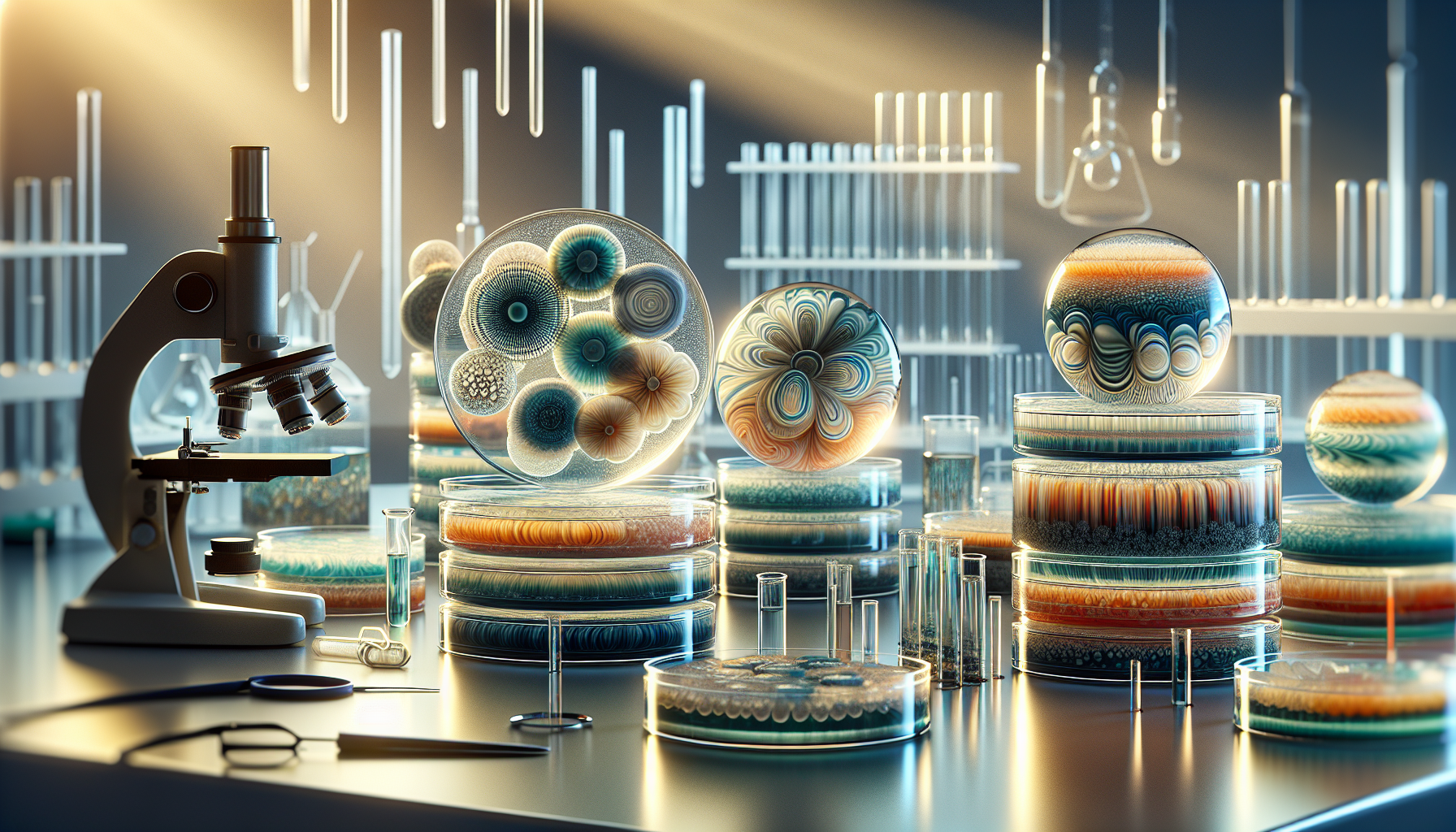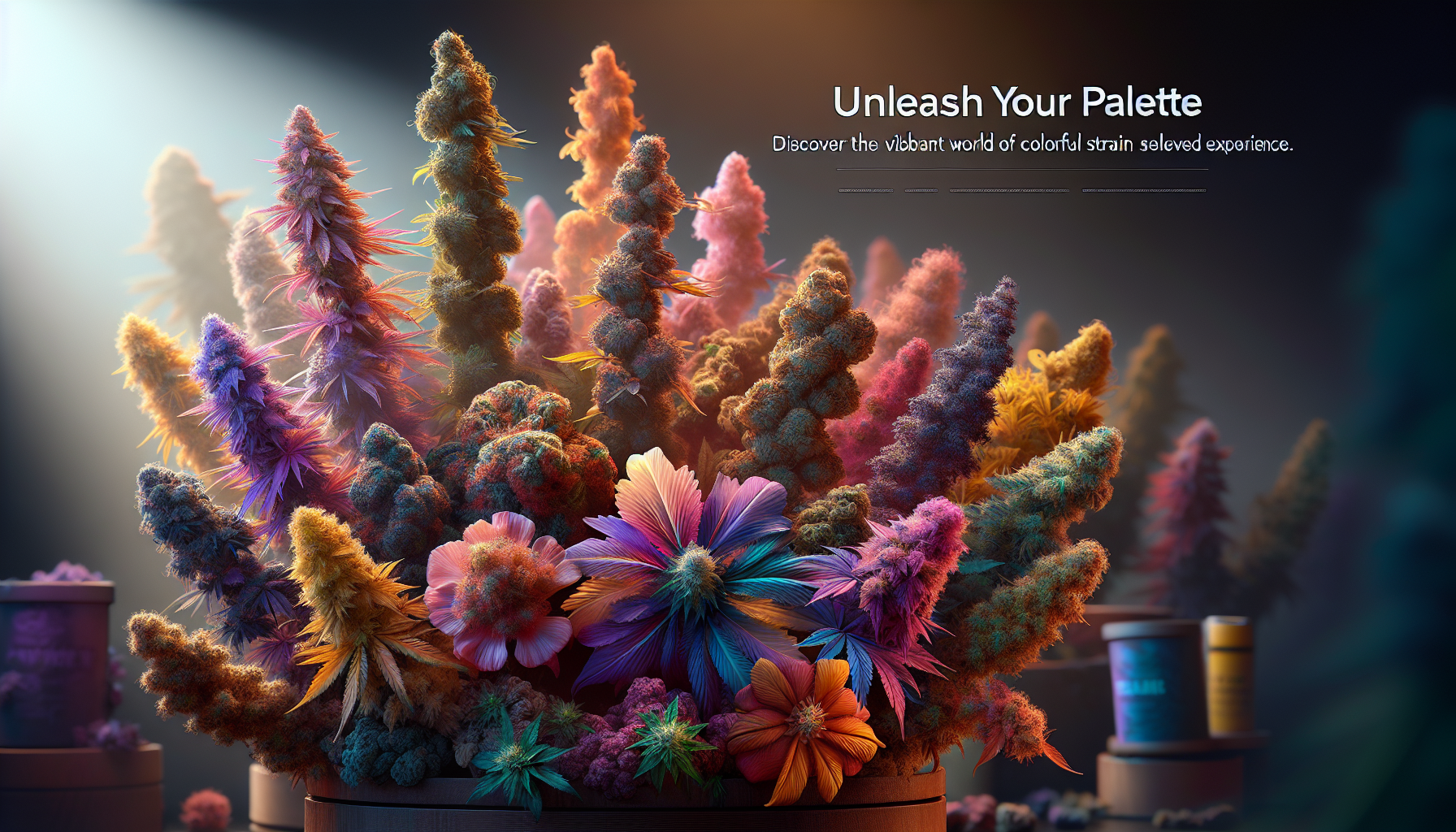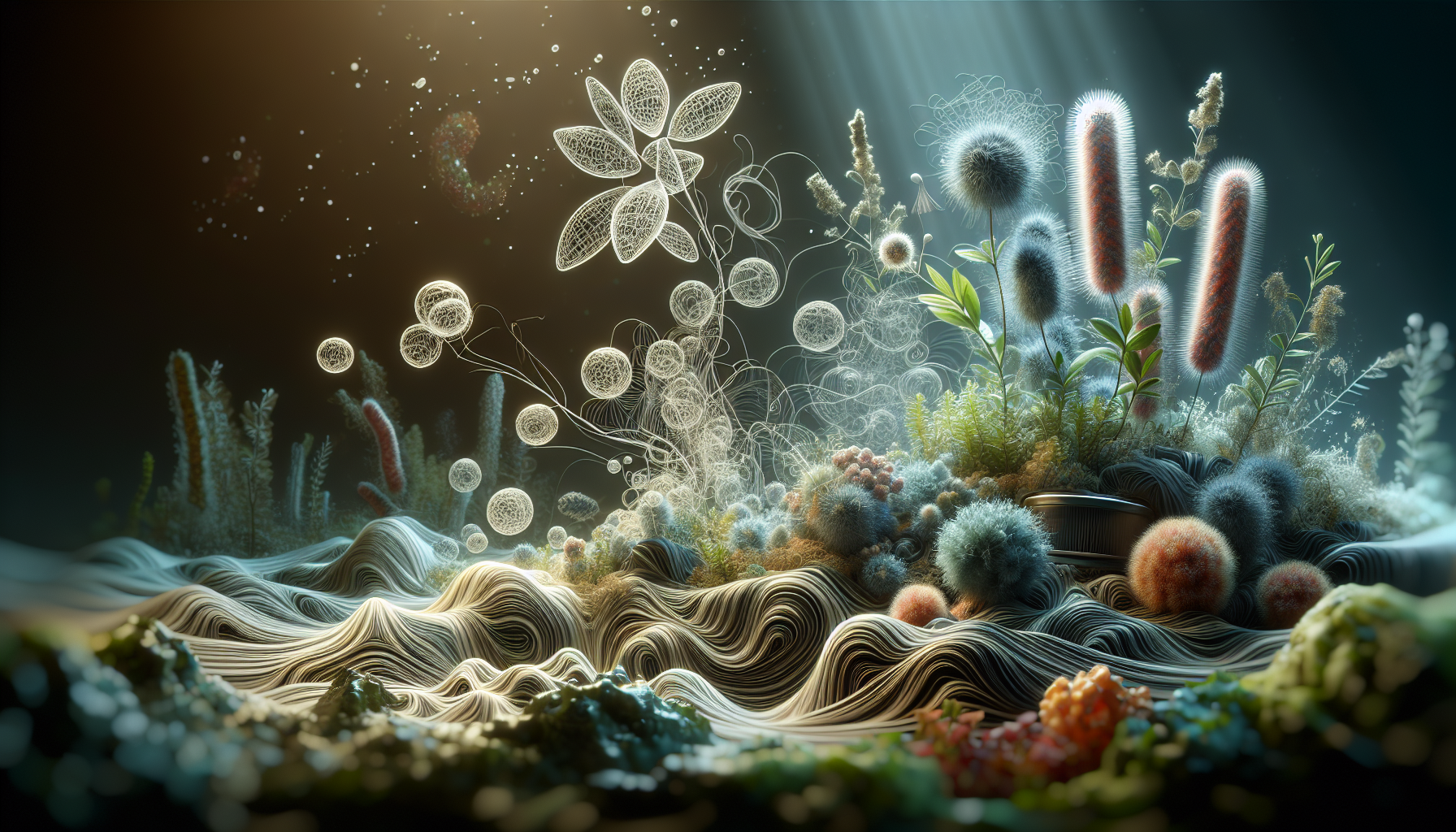In the ever-evolving landscape of culinary artistry, where innovation knows no bounds, one particular medium has been captivating the imaginations of both professional chefs and home cooks alike: layered agar patterns. This unique form of culinary expression transcends traditional boundaries, blending the meticulous precision of scientific experimentation with the boundless creativity of an artist’s palette. In this blog, we will embark on an enchanting journey into the intricate world of layered agar, exploring how this gelatinous canvas is transforming not only the aesthetics of food presentation but also the way we perceive and appreciate culinary craftsmanship.
Agar, a gelatinous substance derived from red algae, has long been a staple in both culinary and scientific fields. Its unique properties make it an ideal candidate for creating stunning, multi-layered patterns that can turn a simple dessert into a breathtaking work of art. But what exactly makes agar so special, and how did it become the darling of innovative chefs and food enthusiasts? The answer lies in its versatility. Agar sets more firmly than gelatin, withstands higher temperatures, and is suitable for a variety of dietary needs, being both vegan and gluten-free. This makes it an appealing choice for those looking to push the boundaries of traditional culinary techniques.
As we delve deeper into the fascinating world of layered agar patterns, we will uncover the delicate balance between science and creativity that defines this art form. We will explore the essential techniques used to create these intricate designs, from choosing the right colors and flavors to mastering the timing and precision required for each layer to set perfectly. Whether you are a seasoned chef or a curious novice, understanding these techniques will open up a world of possibilities, allowing you to create your own edible masterpieces that not only taste exquisite but also tell a story through their visual allure.
Moreover, this exploration will take us into the realm of sensory experiences, highlighting how layered agar patterns engage more than just our taste buds. The vibrant colors and intricate designs captivate our eyes, while the subtle interplay of textures and flavors excites our palates. We will discuss the psychological impact of food aesthetics and how beautifully presented dishes can enhance our dining experience, making every meal a feast for the senses. Through interviews with culinary artists and food psychologists, we will gain insight into the profound connection between visual appeal and taste perception.
Finally, we will provide a step-by-step guide to creating your own layered agar patterns at home, complete with tips and tricks from experts in the field. From selecting the right tools to experimenting with flavor combinations, this guide will equip you with the knowledge and confidence to embark on your own agar adventures. Whether you’re looking to impress your guests with a stunning dessert or simply want to experiment with new techniques in the kitchen, our guide will be your trusted companion on this creative journey.
Join us as we unleash the beauty of layered agar patterns, diving into a world where culinary artistry knows no limits and every dish becomes a canvas for expression. With each layer, we peel back not just the delicate sheets of agar but also the rich tapestry of tradition, innovation, and sensory delight that defines this captivating art form. Prepare to be inspired, informed, and perhaps even a little hungry, as we explore the wonders of layered agar and the endless possibilities it holds for transforming the way we experience food. 🍽️
Understanding the Art of Layered Agar Patterns
Layered agar patterns, often referred to as agar art, represent a unique intersection of science and creativity. This mesmerizing art form uses the medium of agar, a gelatinous substance derived from algae, to create intricate and visually stunning designs. Scientists and artists alike utilize agar in petri dishes, employing various microorganisms and dyes to cultivate patterns that are as beautiful as they are educational. The process is not just about aesthetics; it also provides insight into microbiological processes, allowing for an exploration of growth patterns and interactions between different microbial species.
The beauty of layered agar patterns lies in their transient nature. Unlike traditional art forms that can be preserved for centuries, agar art is ephemeral. The microorganisms used to create these patterns continue to grow and change, transforming the art over time. This dynamic aspect adds a layer of complexity, as creators must consider the life cycle and growth patterns of their chosen microorganisms. The resulting art is a snapshot in time, capturing a moment in the life of these tiny living entities.
Creating layered agar patterns involves a combination of scientific precision and artistic flair. Practitioners must carefully select and prepare their agar medium, often customizing it with different nutrients to influence microbial growth. Then, using tools like pipettes and brushes, they introduce microorganisms onto the agar surface, sometimes incorporating dyes to enhance visual impact. As the microorganisms grow and interact, they form intricate patterns, their complexity limited only by the creator’s imagination and understanding of microbial behavior.
The Science Behind Agar Art
At its core, agar art is a celebration of microbiology. Agar itself is a versatile substance used extensively in laboratories to culture bacteria and fungi. When used in art, it provides a nutrient-rich environment that supports the growth of a variety of microorganisms, each with its unique characteristics. The choice of microorganism is crucial, as different species exhibit distinct growth patterns, colors, and interactions.
Microbiologists often use bacteria such as Escherichia coli or Bacillus subtilis due to their well-documented growth characteristics. These organisms can be dyed with non-toxic pigments to enhance their visual appeal. For instance, E. coli can be genetically modified to express fluorescent proteins, creating stunning bioluminescent effects in the finished artwork. This scientific manipulation not only enhances the art but also demonstrates the power of genetic engineering in creating visual representations of life.
Another fascinating aspect of agar art is the use of competitive and cooperative interactions between microorganisms. Artists can introduce multiple species into a single piece, observing how they interact on the agar medium. Some species may inhibit the growth of others, creating stark contrasts and clear boundaries, while others may coexist harmoniously, blending their colors and patterns. These interactions add depth and narrative to the artwork, as each piece tells a story of competition, survival, and coexistence on a microscopic scale.
Techniques and Tools for Creating Agar Art
Creating layered agar patterns requires a blend of creativity and technical skill. Artists begin by preparing their agar medium, often choosing specific types based on the desired outcome. Nutrient agar is a common choice due to its ability to support a wide range of microbial life. However, specialized agars, such as potato dextrose agar or blood agar, can be used to encourage specific growth characteristics or to provide contrasting backgrounds for the artwork.
Once the agar is prepared and poured into petri dishes, artists can begin the intricate process of designing their patterns. This involves carefully inoculating the agar surface with microorganisms, using tools such as pipettes, brushes, or even toothpicks. Precision is key, as the placement and density of the microorganisms will dictate the final appearance of the artwork. Some artists employ techniques similar to pointillism, placing individual colonies to build up complex images.
To enhance their creations, artists often incorporate dyes or genetically modified organisms that express vibrant colors. These additions can highlight specific features of the design or create striking contrasts. Some artists may also use UV light to illuminate fluorescent proteins, adding a dynamic and ethereal quality to their work. The choice of technique and tools is deeply personal, allowing each artist to express their unique vision through the medium of agar.
Exploring the Limitations and Challenges
While agar art offers endless creative possibilities, it also presents a range of challenges. One of the primary limitations is the transient nature of the medium. As microorganisms grow, they consume the nutrients in the agar and eventually die, causing the artwork to fade over time. Artists must work quickly to capture their creations through photography or video, preserving the ephemeral beauty of their work.
Another challenge lies in the unpredictability of microbial growth. While artists can influence the outcome through careful selection of species and environmental conditions, microorganisms are living entities with their own growth patterns and behaviors. This element of unpredictability adds excitement to the process, but it also means that artists must be prepared to adapt their plans as the artwork evolves.
Finally, working with live microorganisms requires a thorough understanding of microbiological techniques and safety protocols. Artists must ensure that they handle all materials responsibly, minimizing the risk of contamination and ensuring the safety of themselves and others. This technical aspect adds an additional layer of complexity to the creation of agar art, making it a truly interdisciplinary pursuit.
The Impact and Significance of Agar Art
Agar art holds a unique place at the intersection of art and science, offering a platform for exploration and education. It serves as a powerful tool for communicating scientific concepts to the public, breaking down complex ideas into accessible and visually engaging forms. Through agar art, audiences can gain a deeper appreciation for the microscopic world, understanding the beauty and complexity of life at a cellular level.
This art form also provides valuable insights into microbial ecology and behavior. By observing the interactions between different species, artists and scientists can learn about the dynamics of microbial communities, gaining a better understanding of processes such as competition, symbiosis, and succession. These insights have implications for fields ranging from environmental science to medicine, highlighting the importance of microorganisms in maintaining the balance of ecosystems.
Moreover, agar art fosters a sense of wonder and curiosity, encouraging people to explore the world of microbiology. It challenges perceptions of what art can be, expanding the boundaries of creativity and inspiring new approaches to artistic expression. By combining scientific knowledge with artistic vision, agar art celebrates the beauty of the natural world and the ingenuity of human imagination.
Examples of Agar Art in Action
To see the incredible potential of agar art, one can explore the works of renowned artists in the field. For instance, the American Society for Microbiology’s annual agar art contest showcases a wide range of stunning creations, from intricate portraits to abstract designs. Each piece highlights the diversity of microbial life and the creativity of its creator.
Many artists share their processes and finished works through online platforms, offering tutorials and insights into the world of agar art. Videos like “Agar Art: Painting with Bacteria” from the YouTube channel SciShow provide an engaging introduction to the techniques and concepts behind this unique art form. Watch the video to see the magic of agar art in action and discover the stories behind these captivating creations.
Practical Applications and Future Prospects of Agar Art
The intersection of art and science in the form of layered agar patterns opens up a myriad of practical applications and future prospects. One of the most compelling aspects of agar art is its potential to serve as an educational tool. By utilizing agar art in educational settings, educators can make microbiology more accessible and engaging to students of all ages. The visual appeal of the patterns and the hands-on experience of creating them can demystify complex scientific concepts, fostering a greater interest in science, technology, engineering, and mathematics (STEM) fields.
In addition to education, agar art has potential applications in environmental science and public health. Researchers can use this medium to study microbial interactions and ecology in a controlled environment, gaining insights into how microorganisms coexist and compete in natural habitats. Such studies can inform conservation efforts and the development of strategies to mitigate the impact of harmful bacteria on ecosystems. Furthermore, agar art can serve as a tool for public health campaigns, illustrating the importance of hygiene and the spread of microorganisms in a visually impactful manner.
The future of agar art is bright, with potential advancements in technology and science offering new possibilities for creativity and exploration. As genetic engineering and biotechnology continue to evolve, artists may gain access to a broader range of microorganisms with unique properties, expanding the palette of colors and textures available for their creations. Advances in imaging and digital technology could also enhance the documentation and preservation of agar art, allowing for the creation of virtual galleries and interactive experiences that bring these ephemeral works to a wider audience.
Challenges and Considerations for the Future
Despite its many potential benefits, the future of agar art also presents challenges and considerations. One of the primary concerns is the ethical implications of using genetically modified organisms (GMOs) in art. Artists and scientists must navigate the complex regulatory landscape surrounding GMOs, ensuring that their work adheres to safety standards and ethical guidelines. This includes considerations around the release of modified organisms into the environment and the potential impact on natural ecosystems.
Another consideration is the accessibility of agar art to a broader audience. While the field has gained popularity among scientists and artists, it remains relatively niche. Efforts to promote agar art and make it more accessible to the general public could involve workshops, exhibitions, and collaborations with educational institutions. By fostering a community of practice around agar art, practitioners can share knowledge and inspire new generations of artists and scientists to explore this captivating medium.
Finally, the continued development of agar art will require collaboration and interdisciplinary engagement. Artists and scientists must work together to push the boundaries of what is possible, sharing techniques and insights that enrich the field. By embracing this spirit of collaboration, the agar art community can continue to innovate and inspire, opening up new avenues for creative expression and scientific exploration.
The Broader Impact of Agar Art on Society and Culture
Agar art, with its unique blend of science and creativity, has the potential to make a significant impact on society and culture. As an art form, it challenges traditional notions of what art can be, encouraging audiences to see beauty in unexpected places and to appreciate the intricacies of the natural world. By celebrating the diversity and complexity of microorganisms, agar art promotes a sense of wonder and curiosity about the world around us, inspiring people to explore the intersection of art and science.
In a broader cultural context, agar art can serve as a catalyst for conversations about the role of science in society. By making scientific concepts more accessible and engaging, it encourages public engagement with scientific issues and fosters a greater appreciation for the importance of research and innovation. Agar art can also highlight the interconnectedness of all living things, promoting an understanding of the delicate balance of ecosystems and the impact of human activity on the environment.
Moreover, agar art has the potential to bridge cultural divides, serving as a universal language that transcends barriers of language and geography. The visual nature of the art form allows it to communicate complex ideas in a way that is accessible to people from diverse backgrounds, fostering cross-cultural understanding and collaboration. By celebrating the beauty of microbial life, agar art reminds us of our shared connection to the natural world and the importance of protecting and preserving it for future generations.
Engaging with Agar Art: A Call to Action
If you’re intrigued by the world of agar art and want to explore it further, there are many ways to get involved. Whether you’re a scientist, artist, or simply a curious observer, you can engage with this fascinating art form by attending exhibitions, participating in workshops, or experimenting with your own creations. By supporting the agar art community and sharing your experiences, you can contribute to the growth and development of this unique field.
For those interested in learning more, online resources and communities offer a wealth of information and inspiration. Websites and social media platforms dedicated to agar art provide tutorials, galleries, and forums where enthusiasts can connect and share their work. By joining these communities, you can gain valuable insights into the techniques and concepts behind agar art and connect with others who share your passion for this captivating medium.
In conclusion, the world of layered agar patterns is a testament to the beauty and complexity of life at a microscopic scale. By exploring this intersection of art and science, we can gain a deeper understanding of the natural world and our place within it. Whether you’re creating your own agar art or simply appreciating the work of others, this unique art form offers endless possibilities for exploration and inspiration.

Conclusion
Unleashing the Beauty: Discover the Intricate World of Layered Agar Patterns
In conclusion, our exploration into the intricate world of layered agar patterns has been nothing short of mesmerizing. This fascinating intersection of science and art has revealed not only the aesthetic appeal of these patterns but also their significant implications in various scientific fields. Throughout this article, we have journeyed through the process of creating these stunning visuals, discussed the scientific principles underpinning their formation, and highlighted the diverse applications and impacts they have on both the scientific community and art enthusiasts alike.
To recapitulate, we began by delving into the basic understanding of what agar is—a gelatinous substance derived from seaweed—and how its unique properties make it an ideal medium for cultivating bacterial colonies that form beautiful and intricate patterns. We explored how factors such as temperature, nutrient composition, and bacterial species contribute to the diversity of patterns that can be achieved. This understanding is crucial, as it sets the foundation for both the artistic creation and scientific research of these patterns.
We further examined the practical applications of layered agar patterns in various domains. In microbiology, these patterns are not just visually appealing but are instrumental in studying bacterial behavior and interactions. They serve as a window into the microbial world, helping researchers understand complex biological processes and discover new antibiotics. In the realm of art, these patterns offer a unique medium for expression, inspiring artists to blend science with creativity, and fostering a new genre where art meets microbiology.
Moreover, the educational value of layered agar patterns cannot be overstated. They serve as an excellent tool for engaging students and the public in science, offering a tangible and visually stimulating way to learn about microbiology and the importance of bacteria in our world. This aspect underscores the broader impact of these patterns in making science accessible and intriguing to a wider audience.
The importance of this topic extends beyond its immediate applications. It challenges us to reconsider the boundaries between disciplines, encouraging a multidisciplinary approach that can lead to innovative discoveries and creations. By merging the precision of science with the creativity of art, we open new avenues for exploration and understanding, fostering a culture of curiosity and innovation.
As we conclude this journey through the world of layered agar patterns, it is essential to reflect on the broader implications of our exploration. These patterns remind us of the inherent beauty in the microscopic world and the endless possibilities that arise when we dare to explore and experiment. They encourage us to appreciate the small wonders that often go unnoticed and to remain open to the unexpected intersections between different fields of knowledge.
We invite you, our readers, to take this inspiration forward. Whether you are a scientist, an artist, or simply a curious mind, consider how you might apply what you’ve learned in your own work or daily life. Experiment with creating your own agar art, share your findings with others, or delve deeper into the scientific aspects of these patterns. By engaging with this topic, you become part of a larger community that values creativity, curiosity, and the beauty of discovery.
If you found this article insightful or inspiring, please share it with others who might appreciate the fascinating world of layered
Toni Santos is a visual explorer and microscopic storyteller who delves into the hidden aesthetics of microbial life. Through a fusion of scientific curiosity and artistic insight, Toni transforms the overlooked world of bacteria, fungi, and cellular forms into mesmerizing visual narratives—revealing the elegance, symmetry, and chaos that thrive at microscopic scales.
Rooted in a fascination with life forms too small to see yet too intricate to ignore, Toni’s work captures the bizarre beauty of microbial colonies, biofilms, and spore patterns. These images aren’t just representations—they are celebrations of the artistic intelligence encoded in nature’s tiniest architects.
With a background in visual design and bio-inspiration, Toni merges scientific imaging techniques with creative expression, transforming petri dish cultures, fluorescence microscopy, and microbial textures into works that provoke both wonder and contemplation.
As the creative force behind Vizovex, Toni offers curated visual studies, microbial-inspired designs, and essays that bridge art and microbiology—inviting viewers to reimagine what beauty means at the edge of perception.
His work is a tribute to:
The hidden geometries of living systems
The surprising elegance of microbial growth
The role of micro-life in shaping visual culture
Whether you’re a scientist, artist, or simply curious about the unseen world that sustains us, Toni opens a window into a universe where life writes poetry in colonies and patterns, one microbe, one frame, one breathtaking detail at a time.





